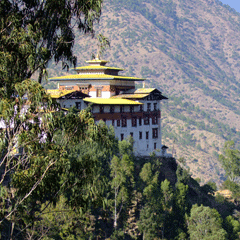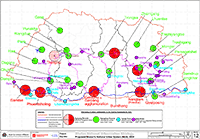|
Project: Bhutan National Urban Development Strategy Partners: Cities Alliance, Ministry of Works and Human Settlement (MoWHS), Thimphu City Cooperation (TCC), United Nations Environmental Programme (UNEP), the World Bank Duration: 2005-2009 Cities Alliance Financing: USD 230,000 Impacts: Promoted effective local government, active citizenship, and pro-poor public and private investment by: -- Increasing efficiency and sustainability in distributing scarce capital -- Creating new and capacitation of local stakeholders |
[4 January 2013] -- The Kingdom of Bhutan’s approximately 738,000 inhabitants live in a unique and challenging environment of high mountains, rivers, virgin forests, and extreme climate changes. Faced with such difficult terrain, Bhutan has developed unevenly; small secondary cities with 1,000 to 5,000 residents dominate the eastern part of the country, while the western part is home to the capital city of Thimphu.
In addition, preserving cultural and national heritage is a key issue in Bhutan—especially in the less accessible and sparsely inhabited parts of the country—and must be at the centre of any urban development plans.
As a result, the Royal Government of Bhutan has adopted a distinct development path that addresses both the challenging physical environment and the country’s emphasis on cultural and national heritage in a distinctive way. It has formulated a medium-term strategy—Bhutan 2020: A Vision for Peace, Prosperity and Happiness—that focuses on happiness, often referred to as Gross National Happiness.
The strategy analyses the present situation and documents a profound and rapid demographic transition, from a subsistence rural economy to an urban society (se e Figure 1). The change is having a significant impact on urban areas, given that liveable and serviced land is scarce, yet urbanisation rates are predicted to increase to up to 10 percent per year. It is estimated that around 250,000 additional people will be living in Bhutan’s cities by 2020.
“The face of our nation is rapidly changing. Increasing numbers of people are choosing to leave their rural homes and to migrate to urban centres.” -- Bhutan National Urbanisation Strategy 2008
Such rapid urban growth offers tremendous economic opportunities, but can often be accompanied by negative aspects such as rising poverty, housing constraints, environmental degradation and unemployment.
Given this situation, the government is seeking to drive urbanisation in a proactive and sustainable way. Decentralisation, preserving cultural heritage, and improving economic development are other issues to be addressed at the national level.
The implementation of the Bhutan National Urban Strategy (BNUS) has had significant impact on Bhutan’s urban areas. It has been an important input and reference document for the urban component of the Royal Government’s 10th Five Year Plan, the country’s most important planning tool. It has also served as a foundation for many urban projects carried out by UNDP, ADB, the World Bank and others.
Fig. 1: Bhutan's estimated urban population growth (Source: World Bank 2012; BNUS 2008)

Funding Strategies Consistent with Happiness

Bhutan's mountainous terrain makes urban development a challenge. Photo: Christopher Fynn
The Cities Alliance—in cooperation with local authorities, UNEP, and the World Bank—supported the development of a National Urban Development Strategy to address social and economic issues related to rapidly expanding cities and to help the Royal Government establish a new spatial framework consistent with Bhutan 2020.
At the same time, the Thimphu City Development Strategy has been developed to guide the country’s main agglomeration, which is expected to be home to more than 100,000 residents by 2020.
The strategies have two objectives. At the national level, they aim to ensure balanced regional growth and strengthen existing urban structures. At the local level, the Thimphu City Development Strategy can serve as a good-practice example for other Bhutanese cities as they develop their own long-term strategic plans.
Development has to be consistent with Bhutan 2020, and both strategies must be implemented in sustainable and environmentally sound ways. Conserving local culture and values are the guiding principles behind every action. Each policy must be consistent with national happiness, as this philosophy is meant to protect the country’s most valuable assets.
A New Spatial Framework to Prioritise Investments
The spatial framework proposed in the National Urbanisation Strategy consists of two major pillars: a National Urban System, which creates a hierarchy between cities; and support for policies and institutional strategies.
The f

irst pillar has established a functional, spatial and regional hierarchy that consists of National or Regional Centres; Dzonkhag, or district, Centres; Medium Towns; and Small Towns. This hierarchy allows the identification of potential economic and/or urban growth centres that are interrelated in an Urban System, sharing responsibilities and developing synergies.
With the different urban centres identified, investments can be made depending on a city’s allocated function. For instance, if a city is identified as a Small Town, it is allocated a market function that promotes investments in local supply facilities.
The second pillar comprises supporting policies that are multisectoral, influencing environmental, cultural, or participation issues. For instance, a community participation framework is proposed to develop institutional arrangements at the Dzongkhag level with the objective of promoting interaction between people and service providers.
As an example of this new spatial framework, plans are underway to develop the town of Gelephu on the southern border with India as a major national city and an important regional centre, with a second airport, railway links, a major industrial park, and a dry port. Gelephu will be linked to other regional growth centres by considerably improving road connectivity, including upgrading the Gelephu-Trongsa and Gelephu-Wangdue highways and constructing the Southern East-West National Highway. All of these measures are being implemented with minimal disruptions to natural and cultural heritage.
Sustainable Through Adaptation
The key lesson learned from the Bhutan experience was the critical importance of adapting development efforts to local philosophies. Because happiness and environmental conservation are core elements of every policy in Bhutan, the strategies had to adopt these as their overreaching goal. This led to a broad acceptance among political institutions and civil society.
There was also an emphasis on capacity building among key stakeholders, with many meetings and workshops that provided the opportunity to share views and recommendations. Additionally, the activity led to new partnerships by connecting government and other stakeholders with involved agencies and personnel.
Notes
[1] Introduced by the Fourth King of Bhutan in the 1970s, Gross National Happiness presents an alternative model for development which places equal weight on the social, spiritual, intellectual, cultural and emotional needs of a society as it does on material and economic gain. The philosophy today garners considerable attention as many nations, both developed and developing, assess the merits of development and, in particular, the extent to which their people’s sense of well-being and happiness is reflected by their levels of material and economic gain.(World Bank 2010)
[2]The Five Year Plans of Bhutan are a series of national economic development plans created by the government of Bhutan since 1961. The 10th plan is the currently active plan for 2008 to 2015. (http://rtm.gnhc.gov.bt/RTMdoc/TenthPlan_Vol1_Web.pdf).
[3] Dzongkhags are the administrative and judicial districts of Bhutan.
Florian Paffenholz is currently working at the Cities Alliance on an internship funded by the German Academic Exchange Service. He specialises in urban geography, waste management in developing countries, and bioenergy discourses in the German/European context.




